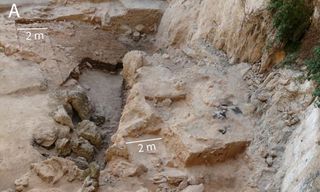Prehistoric Poop Reveals Neanderthals Ate Plants

Don't call them brutes. Neanderthals ate their veggies.
Traces of 50,000-year-old poop found at a caveman campground in Spain suggest that modern humans' prehistoric cousins may have had a healthy dose of plants in their diet, researchers say.
The findings, published today (June 25) in the journal PLOS ONE, are based on chemicals lingering in bits of fossilized feces — perhaps the oldest human poop known to science. [Image Gallery: Our Closest Human Ancestor]
Long-lost cousins
Neanderthals are the closest extinct relatives of Homo sapiens (close enough to have interbred with modern humans). They roamed Eurasia from about 230,000 to 40,000 years ago, and for the most part, they looked like modern humans, but with a stockier build, more prominent brow ridges and wider noses.
Recent research has upended the image of Neanderthals as dim-witted bruisers. These long-gone cousins may have controlled fire, made tools, buried their dead in graves, adorned themselves with feathers and tidied their caves.
Some studies in the past few years have also suggested that Neanderthals weren't just red-meat-gnawing carnivores; instead, they probably had well-rounded diets. Archaeologists found residues of fish scales, bird feathers and starchy plants at a Neanderthal cave in the Rhone Valley in France. Another group of researchers discovered seal, dolphin and fish bones near a Neanderthal hearth on the Rock of Gibraltar, located on the Iberian Peninsula. A 2010 study in the journal Proceedings of the National Academy of Sciences identified microfossils of plants, such as date palms, legumes and grass seeds, stuck in Neanderthal teeth.
Sign up for the Live Science daily newsletter now
Get the world’s most fascinating discoveries delivered straight to your inbox.
For the new study, researchers looked for telltale biomarkers in bits of fossilized feces (often called coprolites) found in the soil at El Salt, an archaeological site in Alicante, Spain, which Neanderthals occupied at various times between 60,000 and 45,000 years ago.
All poop samples indicated that Neanderthals ate animals; evidence came in the form of coprostanol, a lipid created when the body metabolizes cholesterol — a molecule made by all animals. But two samples also had a dash of 5B-stigmastanol — a chemical produced when the gut breaks down phytosterol, a cholesterol-like compound that comes from plants. The researchers billed their study as the first direct evidence that Neanderthals had an omnivorous diet.
Ainara Sistiaga, a graduate student at the University of La Laguna in Spain, who led the investigation as a visiting student at the Massachusetts Institute of Technology, said the results aren't all that surprising, as Neanderthals are primates and most primates are omnivores.
"We cannot say anything about what kind of plants they were actually eating, but some scientists have suggested that in this area they probably had access to berries, nuts or tubers," Sistiaga told Live Science in an email.
Speculative results
Other experts were skeptical about whether the poop in question even belonged to Neanderthals. In pointing a finger at these human cousins, the authors of the paper may have been too quick to rule out bears, wild boars and other omnivores that could have wandered onto the site and left a present.
"It is notoriously difficult to identify the species of coprolites, so it is far from secure that the coprolites they worked on are from humans," said Michael Richards, a researcher at the Max Planck Institute for Evolutionary Anthropology in Germany, who was not involved in the study.
Another researcher noted the questionable placement of the feces — found right next to the fire.
"How would human feces end up close to the cooking place?" asked Hervé Bocherens, of the University of Tübingen in Germany. "We know that modern bears are attracted by abandoned hearths, and they would probably leave droppings behind without any afterthoughts," Bocherens told Live Science in an email.
He added that scientists need a much better reference database for the profile of chemicals they should expect to see in the fossilized feces of different animals, such as bears and humans. Researchers also need a better understanding of how these chemicals degrade over time, he said.
Follow Megan Gannon on Twitter and Google+. Follow us @livescience, Facebook& Google+. Original article on Live Science.

Most Popular

